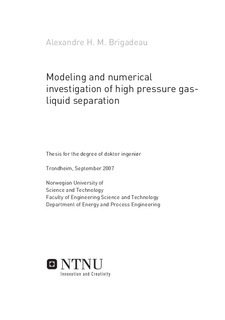| dc.contributor.author | Brigadeau, Alexandre H. M. | nb_NO |
| dc.date.accessioned | 2014-12-19T11:43:35Z | |
| dc.date.available | 2014-12-19T11:43:35Z | |
| dc.date.created | 2007-11-22 | nb_NO |
| dc.date.issued | 2007 | nb_NO |
| dc.identifier | 123012 | nb_NO |
| dc.identifier.isbn | 978-82-471-3666-9 | nb_NO |
| dc.identifier.uri | http://hdl.handle.net/11250/233341 | |
| dc.description.abstract | In this Ph.D. thesis, a model for the study of the efficiency of high-pressure liquid/gas industrial separators has been developed. The model is a three fluid model (gas phase, droplet phase and film phase) and is entirely Eulerian. For the gas phase, a κ - ε model extended to multiphase flows has been used. The turbulent kinetic energy of the dispersed phase, the turbulent dispersion coefficient and the momentum equation of the liquid film were closed algebraicly. The total deposition velocity was determined by turbulent dispersion and a near-wall deposition velocity. The latter was the sum of a non-diffusive term (due to the mean convection of the flow and gravity) and a diffusive term. This diffusive term accounted for the diffusion-impaction deposition regime and the inertia-moderated deposition regime. The gas/liquid film interfacial shear stress was calculated from the local value of the turbulent kinetic energy of the gas. The film acted on the gas as a steady rough wall. An experimental entrainment rate correlation was chosen. The model was implemented in a finite-volume commercial code (Fluent 6.2). The model is based on local closure relations so that it can be further developed for complex industrial geometries.
The results were first compared with experiments from the literature. Deposition rates and film heights were in agreement with the data of the literature. However, the calculated pressure drops were higher and the calculated entrainment rates were lower than the experimental values. The present work pinpoints the reasons of these inaccuracies and corrections to the original model are proposed. The model was finally applied to calculate the efficiency of a vane-pack demister. At atmospheric pressure with air and water the efficiency of the demister was 99.7%. This value agrees with the prediction of a former model from the literature. At high pressure with natural gas and condensate the efficiency of the separator was 0%. The deposition rate was lower, the entrainment rate very high and the liquid layer vanished. | nb_NO |
| dc.language | eng | nb_NO |
| dc.publisher | Fakultet for ingeniørvitenskap og teknologi | nb_NO |
| dc.relation.ispartofseries | Doktoravhandlinger ved NTNU, 1503-8181; 2007:167 | nb_NO |
| dc.title | Modeling and Numerical Investigation of High Pressure Gas-Liquid Separation | nb_NO |
| dc.type | Doctoral thesis | nb_NO |
| dc.contributor.department | Norges teknisk-naturvitenskapelige universitet, Fakultet for ingeniørvitenskap og teknologi, Institutt for energi- og prosessteknikk | nb_NO |
| dc.description.degree | dr.ing. | nb_NO |
| dc.description.degree | dr.ing. | en_GB |
